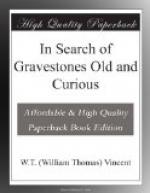Fig. 11.—At Ridley.
“To the three sons of Will.
Deane, died 1704,
1707, and 1709,
aged 2 weeks, 2 years,
and 5 years.”
It is difficult to believe that the face here delineated was meant to represent a skull, and yet, judging by the many equally and more absurd figures which I have since met with, there is little doubt that a skull was intended by the engraver, for this and all others of the class are incised, simply scratched or cut into the stone; nothing so poor in drawing have I ever found which has risen to the eminence of relief. It may, of course, be also surmised that the face here cut into the stone is meant for a portrait or to represent an angelic being. The radial lines may have been intended for a halo of glory or a frilled cap, but, as will be seen by comparison, the whole thing is easily to be classed with the skull series.
[Illustration: Fig. 9. Frankfort.]
[Illustration: Fig. 10. East Wickham.]
It will be noticed that we have in this instance a form of headstone differing materially from those of later times, and wherever we find the rude incised figure we nearly always have the stone of this shape. Such homely memorials are distinguished in nearly every instance by dwarfishness and clumsiness. They are seldom more than 2 feet in height, and are often found to measure from 5 inches to 7 inches in thickness. A prolific field for them is the great marshland forming the Hundred of Hoo, below Gravesend, the scene of many incidents in the tale by Charles Dickens of “Great Expectations.” It is called by the natives “the Dickens country,” for the great author dwelt on the hilly verge of it and knew it well. The Frontispiece shews the general view of one of these old stones at Higham, in the Hoo district.
FRONTISPIECE.—AT HIGHAM.
“To Philip Hawes, died June
24, 1733, aged
19 years.”
In this case the top space is occupied, not by a head or skull, but by two hearts meeting at their points—a not unusual illustration.
At Hoo is one of the coarsest exemplifications of masonic incompetency I have ever encountered.
FIG. 12.—AT HOO, NEAR ROCHESTER
“To Robert Scott, Yeoman, died
24 Dec. 1677,
aged 70 years.”
The nimbus or nightcap again appears as in the Ridley specimen, but, whatever it be, the teeth are undoubtedly the teeth of the skeleton head.
This stone has another claim to our notice beyond the inartistic design. It marks one of the very rare efforts in this direction of the seventeenth century.
The prevalent shape of these old memorials and their almost contemporary dates seem to indicate a fashion of the period, but they are met with in other places of various conformations. There is one at Erith almost square-headed, only 2 feet high, 1 foot 6 inches wide, and 7 inches thick.




